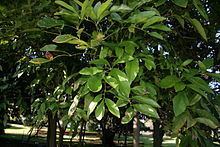Kingdom Plantae Family Proteaceae Species C. araliifolia Rank Genus | Order Proteales Subfamily Grevilleoideae Higher classification Proteas | |
 | ||
Similar Proteas, Placospermum, Opisthiolepis, Hicksbeachia, Franklandia | ||
Carnarvonia is a flowering plant genus of a single species, commonly named red oak or red silky oak and constituting part of the plant family Proteaceae. The single species named Carnarvonia araliifolia grows to large trees of 30 m (100 ft) or more. They grow naturally only (endemic) in the Wet Tropics rainforests region of north-eastern Queensland, Australia. The species has two described varieties, C. araliifolia var. araliifolia and C. araliifolia var. montana, and the common names are used for both.
Contents
C. araliifolia var. araliifolia grows naturally in the lowlands and up to the lower parts of the uplands, from about 50 to 1,000 m (160 to 3,280 ft) altitude. The trees are recorded as developing into the largest size on basalt derived fertile soils.
C. araliifolia var. montana grows naturally in the uplands, tablelands and mountains of the region, from about 650 to 1,300 m (2,130 to 4,270 ft) altitude, with its variety name referring to mountains.
Taxonomy and naming
In 1867, the colonial botanist Ferdinand von Mueller named the species in honour of Henry Herbert, 4th Earl of Carnarvon. In 1995, the Australian tropical rainforest botanist Bernie Hyland updated the description and described the two different varieties.
Phylogenetics studies have indicated that C. araliifolia branched off from an early lineage of the plant family Proteaceae and it retains the ancient characteristics. Botanists have classified the species as a member of the subfamily Grevilleoideae because its cotyledons have auricles, which all other Grevilleoideae have and other Proteaceae outside the subfamily do not have.
Description
C. araliifolia grows up to a tall trees in its native rainforest habitats. The trunks have a pale grey colour and have rounded buttresses with bases likened to an elephant's foot. The compound leaves are up to 35 cm (14 in) long, arranged alternately along the stem. From Nov. to May white–cream flowers grow in panicle–structured compound inflorescences. They grow into woody follicle fruits, ripening from July to March with 1 or 2 winged seeds inside, which sulphur-crested cockatoos eat.
